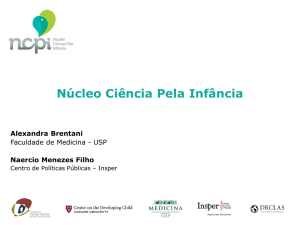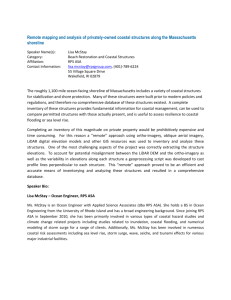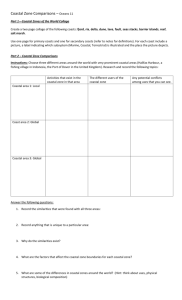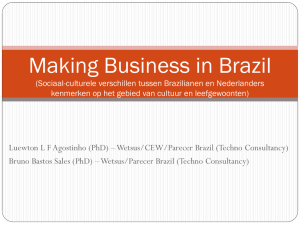The western South Atlantic Ocean in a high
advertisement
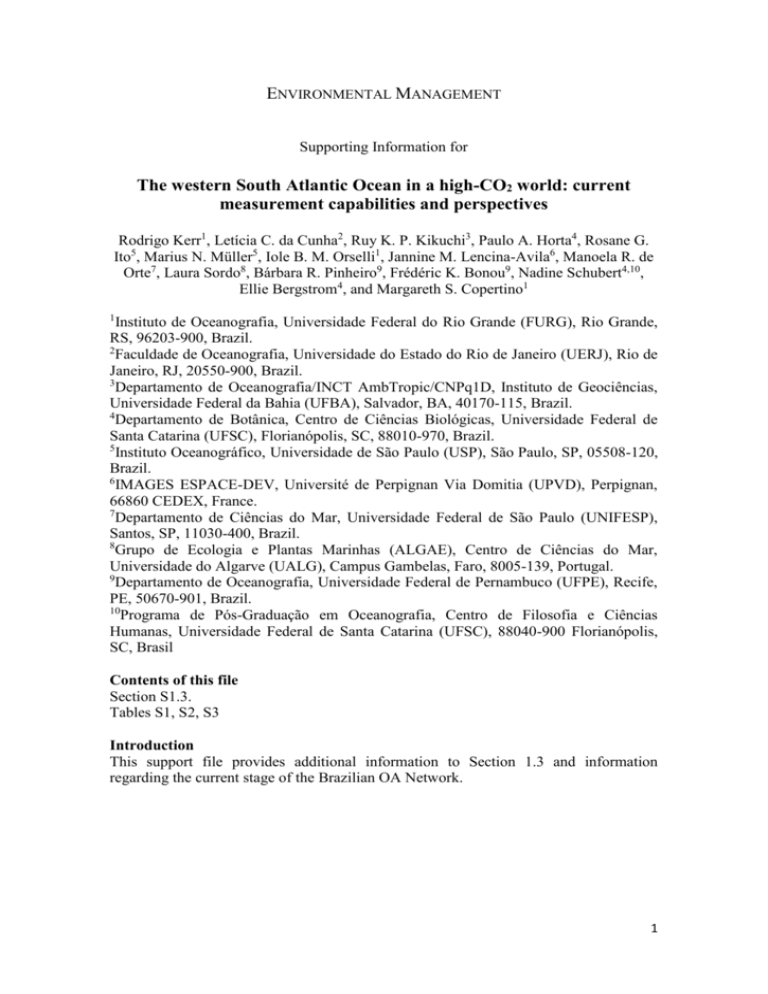
ENVIRONMENTAL MANAGEMENT Supporting Information for The western South Atlantic Ocean in a high-CO2 world: current measurement capabilities and perspectives Rodrigo Kerr1, Letícia C. da Cunha2, Ruy K. P. Kikuchi3, Paulo A. Horta4, Rosane G. Ito5, Marius N. Müller5, Iole B. M. Orselli1, Jannine M. Lencina-Avila6, Manoela R. de Orte7, Laura Sordo8, Bárbara R. Pinheiro9, Frédéric K. Bonou9, Nadine Schubert4,10, Ellie Bergstrom4, and Margareth S. Copertino1 1 Instituto de Oceanografia, Universidade Federal do Rio Grande (FURG), Rio Grande, RS, 96203-900, Brazil. 2 Faculdade de Oceanografia, Universidade do Estado do Rio de Janeiro (UERJ), Rio de Janeiro, RJ, 20550-900, Brazil. 3 Departamento de Oceanografia/INCT AmbTropic/CNPq1D, Instituto de Geociências, Universidade Federal da Bahia (UFBA), Salvador, BA, 40170-115, Brazil. 4 Departamento de Botânica, Centro de Ciências Biológicas, Universidade Federal de Santa Catarina (UFSC), Florianópolis, SC, 88010-970, Brazil. 5 Instituto Oceanográfico, Universidade de São Paulo (USP), São Paulo, SP, 05508-120, Brazil. 6 IMAGES ESPACE-DEV, Université de Perpignan Via Domitia (UPVD), Perpignan, 66860 CEDEX, France. 7 Departamento de Ciências do Mar, Universidade Federal de São Paulo (UNIFESP), Santos, SP, 11030-400, Brazil. 8 Grupo de Ecologia e Plantas Marinhas (ALGAE), Centro de Ciências do Mar, Universidade do Algarve (UALG), Campus Gambelas, Faro, 8005-139, Portugal. 9 Departamento de Oceanografia, Universidade Federal de Pernambuco (UFPE), Recife, PE, 50670-901, Brazil. 10 Programa de Pós-Graduação em Oceanografia, Centro de Filosofia e Ciências Humanas, Universidade Federal de Santa Catarina (UFSC), 88040-900 Florianópolis, SC, Brasil Contents of this file Section S1.3. Tables S1, S2, S3 Introduction This support file provides additional information to Section 1.3 and information regarding the current stage of the Brazilian OA Network. 1 Supporting Material S1.3. Key Sensitive Brazilian ecosystems S1.3.1. Large to Medium Rivers Here, we assess the main features of the four most important rivers in Brazil (Fig. 1B) based on basin area and discharge. On the northern Brazilian coast, the Amazon River discharges a large amount of freshwater (average 163,000 m3 s-1, or 18% of the total freshwater input to the world's oceans by rivers; Labat et al. 2004), sediments (1.2 Pg yr-1, DeMaster et al. 1986), carbon (43 Tg organic C yr-1 and 26 Tg inorganic C yr-1, Probst et al. 1994, Coynel et al. 2005), and nutrients directly to the Tropical Western Atlantic Ocean continental shelf. In this region, a large, low-salinity, nutrient-rich river plume area off the coast (up to 2 × 106 km2, Cooley et al. 2007) enhances primary production, creating a regional CO2 sink in the equatorial Atlantic Ocean (Subramaniam et al. 2008). However, all the biogeochemical processes within the plume are not well constrained. Other threats to the Amazon River Basin (~6,890 × 103 km2) include deforestation, damming, contamination from gold mining and sewage, and overfishing (Castello et al. 2013). Small quantities of freshwater are discharged along the remaining Brazilian continental shelf. Three more important medium-sized riverine inputs are located on the NE and E shelf (Fig. 1B), namely, the São Francisco, Doce and Paraíba do Sul Rivers, with average discharges of 28-120 km3 yr-1. Over the last century, these rivers have suffered the impacts of urbanization (cities, industries, and mining plants), aquaculture, dam construction, and agriculture along their drainage basin. However, these rivers have preserved areas, and their basins support discontinuous patches of Atlantic Rain Forest (UNEP, 2004). These riverine plumes and their influences (sediment and nutrient 2 inputs) are restricted to a narrow area in the oligotrophic NE and E shelf region (Bernardes et al. 2012, de Oliveira et al. 2012). S1.3.2. Estuarine ecosystems Coastal areas, including estuaries and lagoons, play important roles in the marine carbon cycle because of their high productivity over a small surface area (~8% of the global ocean surface; Chen & Borges, 2009). In estuaries, all the materials that are transported from the drainage basin are transformed before being exported to the adjacent ocean. Because of the biogeochemical processes in sediments and the water column, many estuarine areas act as sources of CO2 to the atmosphere (Borges & Abril, 2011). However, exporting carbon and nutrients to the coastal ocean may increase local primary production and vertically transport of carbon to open ocean waters. These processes characterize the so-called continental shelf pump and are responsible for the average atmospheric CO2 sink over shelf areas (Chen & Borges, 2009). Most of the Brazilian population lives in cities along portions of the coast or within estuaries, bays or lagoons that provide services, such as harbours, tourism, aquaculture, and fisheries (UNEP 2004). In these areas, natural eutrophication is enhanced by heavy cultural eutrophication, and related scientific literature covers the physical and biological features of the main Brazilian coastal ecosystems (Fig. 1B). From a marine biogeochemistry perspective, an insufficient amount of literature is available regarding the carbonate system parameters and the roles of ecosystems as CO 2 sinks or sources. Noriega et al. (2015) and Araújo et al. (2014) recently demonstrated that the tropical estuaries along the N/NE Brazilian coast behave as sources of CO2 to the atmosphere. Additionally, the partial pressure of CO2 (pCO2) in surface estuarine waters 3 is negatively correlated with dissolved oxygen saturation, which indicates control by biological processes, particularly organic matter degradation, resulting in greater dissolved CO2 concentrations and the further acidification of coastal waters. Southwards along the coast, Cotovitz et al. (2015) showed that Guanabara Bay (the metropolitan area of Rio de Janeiro) behaves as a net sink for atmospheric CO2 despite its heavy eutrophication and daily/seasonal variability. This behaviour is possible because of the combination of light and nutrient availability triggers primary production and high organic matter burial rates in the sediments. The N/NE Brazilian estuaries (CO2 sources) and Guanabara Bay (a CO2 sink) reinforce the need for additional field data on the full carbonate system in the coastal ecosystems of Brazil to understand the possible interplay between OA and eutrophication. S1.3.3. Coastal lagoons Coastal lagoons constitute approximately 13% of the world’s coastline and vary considerably in shape, size, climate, hydrology, and trophic state (Nixon 1995, Windom et al. 1999). In addition, these ecosystems are efficient sediment and nutrient traps and nursery areas to many marine species and are becoming increasingly important as tourism zones (Knoppers et al. 1999). A series of choked coastal lagoons, often separated from the ocean by a sand bar, and with limited water exchange with the adjacent ocean exist along the Brazilian coast (Kjerfve 1986). Densely populated areas are found around their , and the lagoons are often heavily affected by human activities (da Cunha & Wasserman 2003, Niencheski et al. 2014). As examples we may cite the Patos Lagoon (S Brazil, Fig. 1B), the largest choked lagoon in the world (10,200 km2), houses harbours for the cities of Porto Alegre and Rio Grande, and the Araruama Lagoon, one of the largest hypersaline 4 lagoons (210 km2, salinity range from 42 to 56) in the world, part of the Fluminense Lagoon complex (SE Brazil, Fig. 1B) (Kjerfve et al. 1996, Souza et al. 2003). High primary production rates in Brazilian coastal lagoons increase autochthonous organic matter production and benthic microbial activity. Higher oxygen consumption results in temporary hypoxic to anoxic (and thus acidic) conditions in the sediment-overlying water column and the concomitant release of sulphides (Souza et al 2003, Cunha & Wasserman 2003). Currently, no studies exist that detail the effects of acidification on water or biota. S1.3.4. Mangroves Mangroves are dominant coastal ecosystems that cover more than 200,000 km2 of sheltered tropical and subtropical coastlines. Currently, approximately 50% of this area has been lost because of anthropogenic pressures (Duke et al. 2007). In Brazil, mangrove forests occur along the coast from the north up to a latitude of 28.5o S, covering approximately 91.6% of the Brazilian coastline (Fig. 1B, Schaeffer-Novelli et al. 2000). Brazilian mangroves represent 7.1% of these ecosystems worldwide (Magris & Barreto 2010). Estimations of photosynthetic rates indicate that mangroves are more productive over a given area than other coastal ecosystems (Alongi 2002). Therefore, mangroves are efficient carbon sinks that are collectively referred to as blue carbon along with seagrasses and saltmarshes (UNEP 2009). If the maximum estimates of the globally covered area are combined with the upper estimates of the buried carbon per unit area, the carbon capture capacity of blue carbon sinks is more than 300 Tg C year–1. In addition, mangroves are important for controlling floods; protecting against erosion, 5 storms, and wave damage; maintaining water quality and serve as nurseries and feeding areas for several fish species (Alongi 2002). Mangroves are impacted by distinct components of climate change, including changes in sea level, extreme events and atmospheric CO2 concentrations. Increasing CO2 concentrations may result in some positive changes for these ecosystems, as it may lead to increasing photosynthesis and mangrove growth rates (UNEP 1994). Soares et al. (2012) proposed a conceptual model where the southern limit (latitude 28° S) for Brazilian mangrove forests would be pushed southwards in response to the trend in increasing average SST and air temperature. S1.3.5. Seagrasses Seagrass meadows form complex habitats that influence the physical, chemical and biological characteristics of coastal environments (Orth et al. 2006). By increasing the primary production and complexity of the sediment, seagrasses provide food and breeding/nursery areas for invertebrates and fish (Waycott et al. 2009). Together with mangroves and salt marshes, seagrass ecosystems are important carbon sinks that represent a potential reservoir of up to 19.9 Pg of organic C globally (Fourqurean et al. 2012). Seagrass habitats have significantly decreased in size (by at least 30%, with loss rates between 2 and 7% yr-1) during the last century (Waycott et al. 2009) because of coastal urbanization, eutrophication, land reclamation, overfishing and recent global climate change (Duarte 2002). The conservation status of Brazilian seagrasses is critical. The unsustainable exploitation and occupation of coastal areas and the multifold anthropogenic footprints that remain from the last 100 years have resulted in degradation losses, particularly in estuarine areas and coastal lagoons (Copertino et al. 6 under review). Few studies have investigated the responses of Brazilian seagrasses to climate change (Copertino et al. under review, Sordo & Lana under review), although seagrass species are highly vulnerable to global climate changes (e.g., Duarte 2002). Specific investigations of the effects of OA on seagrasses in Brazil have not been conducted; however, an initiative is currently underway to investigate the metabolic feedbacks between seagrasses and rhodoliths in order to monitor their community structure and review community carbon budgets under current conditions and future scenarios. S1.3.6. Salt marshes Salt marshes are major coastal ecosystems in the intertidal depositional areas of prograding coasts in temperate climates (Davy & Costa 1992). Similar to mangroves, salt marshes shelter coasts from erosion and support fisheries by acting as important spawning and nursery habitats (Pennings & Bertness 2001). South-western Atlantic coastal saltmarshes develop on areas that are dominated by the tidal flats of rivers, lagoons, creeks, coves and bays, or in association with mangroves (Davy & Costa 1992) At latitudes greater than 28.5° S, salt and brackish marshes occupy extensive areas off the coast of southern Brazil, Uruguay and northern Patagonia and at riverine and estuarine margins with large freshwater discharge and prevailing brackish conditions (Isacch et al. 2006). Salt marshes are among the most extreme marine habitats in terms of natural pH and dissolved oxygen variability (Duarte et al. 2013). Despite the physiological tolerance and theoretical adaptation potentials of many salt marsh species (Parker et al. 2011), decreasing pH and dissolved oxygen may be deleterious, particularly to shellfish animals and juvenile fish. Thus, these ecosystems may be largely insensitive to elevated CO2 levels (Hendriks et al. 2010). However, such organisms may already live near the 7 edge of their physiological potential and could respond negatively to any further changes that increase the environmental extremes in their habitat (Hofmann et al. 2011). No studies have been conducted to determine the effects of CO2 and OA in Brazilian salt marshes. The exposure of viable ecosystems to extreme conditions presents unique and natural experimental opportunities that are near the heart of the following current OA research questions: Are these ecosystems more likely to be pushed past ‘tipping points’ by continued anthropogenic acidification? Alternatively, are these ecosystems more likely to adapt to changing conditions? Reference list for Support Section 1.3 (S1.3.) Alongi DM (2002) Present state and future of the world’s mangrove forests. Environ Conserv 29:331-349 Ball MC, Cochrane MJ, Rawson HM (1997) Growth and water use of the mangroves Rhizophora apiculata and R. stylosa in response to salinity and humidity under ambient and elevated concentrations of atmospheric CO2. Plant Cell Environ 20:1158-1166 Castello L, McGrath DG, Hess LL, Coe M, Lefebvre PA, Petry P, Macedo MN et al. (2013) The vulnerability of Amazon freshwater ecosystems. Conserv Lett 6:217–229, doi: 10.1111/conl.12008 Coynel A, Seyler P, Etcheber H, Meybeck M, Orange D (2005) Spatial and seasonal dynamics of total suspended sediment and organic carbon species in the Congo River, Global Biogeochem Cy 19(4):GB4019, doi:10.1029/2004GB002335 Da Cunha LC , Wasserman JC (2003) Relationships between nutrients and macroalgal biomass in a Brazilian coastal lagoon: the impact of a lock construction. Chem Ecol 19:283–298. doi: 10.1080/0275754031000095732 DeMaster DJ, Kuehl SA, Nittrouer CA (1986) Effects of suspended sediments on geochemical processes near the mouth of the Amazon River: examination of biological silica uptake and the fate of particle-reactive elements, Cont Shelf Res 6(1-2):107–125, doi:10.1016/0278-4343(86)90056-7 de Oliveira EN, Knoppers BA, Lorenzzetti JA, Medeiros PRP, Carneiro M, de Souza WFL (2012) A satellite view of riverine turbidity plumes on the NE-E Brazilian coastal zone. Braz J Oceanogr 60(3):283–298, doi:10.1590/S1679-87592012000300002 Duarte CM (2002) The future of seagrass meadows. Environ Conserv 29:192-206. 8 Duarte CM, Losada IJ, Hendriks IE, Mazarrasa I, Marbà N (2013) The role of coastal plant communities for climate change mitigation and adaptation. Nature Clim Change 3:961–968 Duke NC, Meynecke J-O, Dittmann S, Ellison AM, Anger K, Berger U, Cannicci S et al. (2007) A world without mangroves? Science 317:41–42 Fourqurean JW, Duarte CM, Kennedy H, Marba N, Holmer M, Angel Mateo M, Apostolaki AT et al. (2012) Seagrass ecosystems as a globally significant carbon stock. Nature Geosci 5:505–509. Hendriks IE, Duarte CM, Álvarez M (2010) Vulnerability of marine biodiversity to ocean acidification: A meta-analysis. Estuar Coastal Shelf S 86:157–164 Hofmann GE, Smith JE, Johnson KS, Send U, Levin LA, Micheli F, Paytan A, et al. (2011) High-frequency dynamics of ocean pH: A multi-ecosystem comparison. PLoS One 6:e28983 Isacch JP, Costa CSB, Rodríguez-Gallego L, Conde D, Escapa M, Gagliardini DA, Iribarne OO (2006) Distribution of saltmarsh plant communities associated with environmental factors along a latitudinal gradient on the south-west Atlantic coast. J Biogeogr 33:888–900 Jiang Li‐Q, Cai W‐J, Wanninkhof R, Wang Y, Luger H (2008) Air‐sea CO2 fluxes on the U.S. South Atlantic Bight: Spatial and seasonal variability. J Geophys Res– Oceans 113:C07019, doi:10.1029/2007JC004366 Kjerfve B (1986) Comparative oceanography of coastal lagoons. In Estuarine Variability., pp. 63–81. Ed. by DA Wolfe. Academic Press, New York. Kjerfve B, Schettini CAF, Knoppers B, Lessa G, Ferreira HO (1996) Hydrology and Salt Balance in a Large, Hypersaline Coastal Lagoon: Lagoa de Araruama, Brazil, Estuar Coastal Shelf S 42:701–725, doi:10.1006/ecss.1996.0045 Knoppers B (1994) Aquatic Primary Production in Coastal Lagoons. In Elsevier Oceanography Series, pp. 243–286. Ed. by B Kjerfve. Elsevier Science Publishers B. V., Amsterdam. Knoppers BA, Carmouze JP, Moreira-Turcq PF (1999) Nutrient dynamics, metabolism and eutrophication of lagoons along the East Fluminense coast, state of Rio de Janeiro. In Environmental Geochemistry of Coastal Lagoon systems of Rio de Janeiro, Brazil., pp. 123–154. Ed. by BA Knoppers, ED Bidone, JJ Abrão. UFF - FINEP, Niterói. Labat D, Ronchail J, Callede J, Guyot JL, de Oliveira E, Guimarães W (2004) Wavelet analysis of Amazon hydrological regime variability. Geophys Res Lett 31(2):L02501, doi:10.1029/2003GL018741 Magris RA, Barreto R (2010) Mapping and assessment of protection mangrove habitats in Brazil. Panam J Aquat Sci 5(4):546-556 9 Niencheski LF, Moore WS, Windom HL (2014) History of human activity in coastal southern Brazil from sediment. Mar Pollut Bull 78(1-2):209–212, doi:10.1016/j.marpolbul.2013.10.042 Oliveira AM, Kjerfve B (1993) Environmental responses of a tropical coastal lagoon system to hydrological variability: Mundaú-Manguaba, Brazil, Estuar Coastal Shelf S 37:575–591, doi:10.1006/ecss.1993.1074 Orth RJ, Carruthers TJB, Short FT, Dennison WC, Duarte CM, Fourqurean JW, Heck Jr KL et al. (2006) A Global Crisis for Seagrass Ecosystems. BioScience 56 (12):987–996. Parker VT, Callaway JC, Schile LM, Vasey MC, Herbert ER (2011) Climate Change and San Francisco Bay-Delta Tidal Wetlands. San Francisco Estuary and Watershed Science 9(3):1-15 Pennings SC, Bertness MD (2001) Salt marsh communities. Marine community ecology: 289–316. Sinauer Associates, Sunderland, MA. Probst JL, Mortatti J, Tardy Y (1994) Carbon river fluxes and weathering CO2 consumption in the Congo and Amazon river basins. Appl Geochem 9(1):1–13, doi:10.1016/0883-2927(94)90047-7 Schaeffer-Novelli Y, Molero-Cintrón G, Soares MLG, De-Rosa T (2000) Brazilian mangroves. Aquat Ecosyst Health Manag 3(4):561-570 Soares MLG, Estrada GCD, Fernandez V, Tognella MMP (2012) Southern limit of the Western South Atlantic mangroves: Assessment of the potential effects of global warming from a biogeographical perspective. Estuar Coast Shelf Sci 101:44–53. doi: 10.1016/j.ecss.2012.02.018 Souza MFL, Kjerfve B, Knoppers B, Landim de Souza WF, Damasceno RN (2003) Nutrient budgets and trophic state in a hypersaline coastal lagoon: Lagoa de Araruama, Brazil, Estuar Coastal Shelf S 57(5-6):843–858, doi:10.1016/S0272-7714(02)00415-8 Subramaniam A, Yager PL, Carpenter EJ, Mahaffey C, Björkman K, Cooley S, Kustka AB et al. (2008) Amazon River enhances diazotrophy and carbon sequestration in the tropical North Atlantic Ocean. P Natl Acad Sci USA 105(30):10460–5, doi:10.1073/pnas.0710279105 UNEP (1994) Regional Seas Reports and Studies No. 154: Assessment and monitoring of climatic change impacts on mangrove ecosystems. 62 pp. UNEP (2004) Global International Waters Assessment Brazil Current, GIWA Regional assessment 39. University of Kalmar on behalf of United Nations Environment Programme, Kalmar, Sweden. 192 pp. UNEP (2009) Blue Carbon: The Role of Healthy Oceans in Binding Carbon: a Rapid Response Assessment. Rapid Response Assessment. GRID-Arendal. 10 Waycott M, Duarte CM, Carruthers TJB, Orth RJ, Dennison WC, Olyarnik S, Calladine A et al. (2009) Accelerating loss of seagrasses across the globe threatens coastal ecosystems. P Natl Acad Sci USA 106:12377–12381 Windom HL, Niencheski LF, Smith Jr. RG (1999) Biogeochemistry of nutrients and trace metals in the estuarine region of the Patos Lagoon (Brazil). Estuar Coastal Shelf S 48:113–123 11 Support Tables Table S1. Acronyms of Brazilian states and institutions that were cited within the text. Brazilian States Amapá Bahia Maranhão Pará Paraná Pernambuco Rio de Janeiro Rio Grande do Sul São Paulo Santa Catarina Brazilian Institutions Universidade de São Paulo Universidade do Estado do Rio de Janeiro Universidade Estadual de Santa Cruz Universidade Federal Fluminense Universidade Federal da Bahia Universidade Federal de Pernambuco Universidade Federal de Santa Catarina Universidade Federal de São Paulo Universidade Federal do Rio de Janeiro Universidade Federal do Rio Grande Acronyms AP BA MA PA PR PE RJ RS SP SC Acronyms USP UERJ UESC UFF UFBA UFPE UFSC UNIFESP UFRJ FURG 12 Table S2. Summary of the carbonate system parameters, methodology, and study regions of the Brazilian Ocean Acidification Network participants. Oceanic regime Parameter State Institution Methodology Compartment Main Focus Open Measured Shelf Slope Ocean RS SC FURG UFSC USP SP UNIFESP UFRJ Coral Vivo UERJ RJ Cont. pCO2 LI-COR 7000 Surface Ocean and Atmosphere yes yes yes AT / CT pH Closed Cell Electrode (NBS) Water Column yes yes yes yes yes yes pCO2 Equilibrator AT pH AT Open Cell Electrode (NBS) Open Cell - - CT LI-COR 7000 - - 13C - 18O IRMS Seabed / Sediment AT Open Cell pH Electrode (NBS) AT Open Cell pH Electrode (NBS) Water Column and Seabed / Sediment Rock Shore Seabed Corals, Rhodolith Beds and Seagrass AT pCO2 AT pH Open Cell Electrode (NBS and potentiometry) LI-COR 7000 EGM4pp-systems Gas Chromatography Open Cell Electrode (NBS) Cont. pCO2 LI-COR 7000 AT Open Cell pH pCO2 and Cont. pCO2 AT Electrode (NBS) PIRATA Buoys CARIOCA Buoys Open Cell Electrode(NBS) Spectro (Total) pH Cont. pCO2 UFF UESC BA UFBA PE UFPE pH Several* SiMCosta* pCO2 pH CARIOCA Buoys Seabed Rhodolith Beds and Seagrass Inner Surface Ocean - - - - Inner - - yes yes yes yes yes yes - - - yes yes - - Surface Ocean and Atmosphere - - - Seabed Corals and Seaweed - - - Surface Ocean and Atmosphere yes yes yes Water Column Inner - Atmosphere Surface Ocean yes yes - Water Column Surface Ocean and Atmosphere Surface Ocean Carbonate System CO2 Net Flux Anthropogenic Carbon Field Observations Experiments with Field Incubation Experimental Factors: OA, T, Nutrients and Metals Experiments with phytoplankton Experimental Factors: OA Mineralized organisms: Foraminiferous Experiments with invertebrates Experimental Factors: OA and Metals Mesocosm Experiments Experimental Factors: OA, T, Nutrients and Metals Carbonate System / Field Observations Study Region Brazilian continental shelf and slope from RJ to RS States Patos Lagoon Estuary Antarctic Peninsula Florianópolis Coast (SC) Ubatuba City (SP) South Atlantic Ocean Santos Estuary (SP) Arraial d’Ajuda City (BA) Estuarine and coastal systems (RJ) Guanabara Bay (RJ) CO2 Net Flux / Field Observations Coastal Lagoons (RJ) Antarctic lakes, bays and Coastal zones yes CO2 Net Flux / Field Observations Experiments with Corals and Seaweed Experimental Factors: OA, T Ocean Modelling / Monitoring Programme Experiments with Corals yes Experimental Factors: OA, T NE Brazil and Oceanic Islands Monitoring Programme SE to S of Brazil - Estuarine systems Estuarine systems and Coral reefs Tropical Atlantic and Oceanic Islands *Including FURG (RS), USP (SP), UFPR (PR) and UFSC (SC). 13 Table S3. Summary of OA-related Brazilian oceanographic cruises over the last seven years. The majority of the works remain unpublished or are currently in preparation. Study Area Antarctic Peninsula area (Bransfield Strait and NW Weddell Sea) Patagonian Continental Shelf (PATEX cruises I to VII; only PATEX IV and VI measured all parameters listed) South Atlantic Ocean – sections along 20º S and 30ºS South Brazil Bight (shelf/slope zone) Ship Sampled Year Cont. pCO2 Jan. 2008, Jan. 2009, and Jan. 2010 N.Ap.Oc. Ary Rongel (H44) Cont. pCO2, AT/CT and pH (Total) Nov. 2004 (I), Oct. 2006 (II), Mar. 2007 (III), Oct. 2007 (IV), Jan. 2008 (V), Oct. 2008 (VI), and Jan. 2009 (VII) NHo Cruzeiro do Sul (H38) Cont. pCO2 Nov. to Dec. 2009 NHo Cruzeiro do Sul (H38) Cont. pCO2 Dec. 2010 to Jan. 2011 South Atlantic Ocean – section along 35ºS NHo Cruzeiro do Sul (H38) Cont. pCO2 and pH (NBS) Oct. to Dec. 2011 South Shetland Islands, Antarctic Peninsula (coastal areas) NPo. Almirante Maximiano (H41) Cont. pCO2 Jan. 2013 NOc. Antares (H40) Cont. pCO2 and AT Jul. to Sep. 2014 AT/CT and pH (NBS) Jul. to Sep. 2014 AT/CT and pH (NBS) Sep. to Oct. 2014 Cont. pCO2 AT/CT and pH (NBS) Oct. 2014 South Atlantic Ocean – section along 38ºW (PIRATA cruise) Tropical Atlantic Islands (NE Brazil) Amazon River Plume South Brazil Bight (shelf/slope zone; EstARteSul cruise) South Brazilian shelf (INCTMAR-COI cruise) Antarctic Peninsula Area (Bransfield and Gerlache Straits) South Atlantic Ocean – section following Agulhas eddies N.Ap.Oc. Ary Rongel (H44) CO2-related Parameters Measured NHo Cruzeiro do Sul (H38) NHo Cruzeiro do Sul (H38) NHo Cruzeiro do Sul (H38) Outcome Ito et al. (in prep.) BrOA Action PI No Dr. C.A.E. Garcia No Dr. C.A.E. Garcia No Dr. C.A.E. Garcia No Dr. C.A.E. Garcia No Dr. C.A.E. Garcia - No Dr. H. Marotta (Invited to cooperate) Dr. R. Vieira (cruise PI) Processing AT analysis Yes Dr. M. Araújo No Dr. R. Schwamborn Yes Dr. M. Araújo Yes Dr. R. Kerr Orselli et al. (in prep.) Ito et al. (in prep.) Ito et al. (under review) LencinaAvila et al. (under review) Processing AT/CT analysis Processing AT/CT analysis AT/CT analysis done NOc. Atlântico Sul AT/CT Jan 2015 AT/CT analysis done Yes Dr. R. Kerr (Invited to cooperate) Dr. L. F. Niencheski (cruise PI) NPo. Almirante Maximiano (H41) AT/CT and pH (NBS) Feb. 2015 AT/CT analysis done Yes Dr. R. Kerr NPqHo. Vital de Oliveira Cont. pCO2 AT/CT and pH (Total scale) Jul. 2015 Processing AT/CT analysis Yes Dr. L. C. da Cunha & R. Kerr 14


